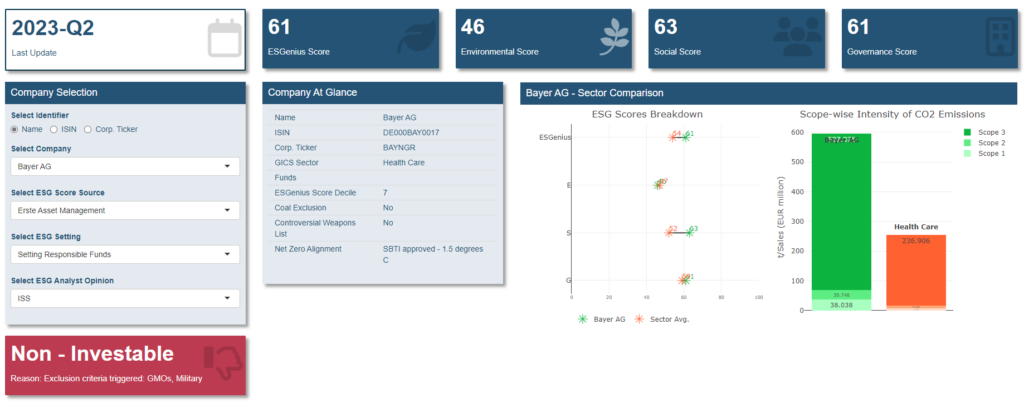When Bayer finally announced its deal to take over the US-based agrochemical and crops behemoth Monsanto in 2018, executives in both board rooms surely felt relief over the successful completion of the deal. The deal valued at roughly USD 64bn raised a couple of tantalising questions, though. Firstly, Monsanto’s history of controversial practices, such as aggressive litigation against farmers and inadequate labelling of genetically modified organisms (GMOs), has drawn public outrage1. By merging with Monsanto, Bayer became responsible for these practices, potentially tarnishing its own ESG reputation.
A quick ESG glimpse onto Bayer AG
According to Erste AM’s proprietary ESGenius Score we can easily gauge Bayer’s ESG profile. There are some positive aspects, such as an SBTi-approved decarbonisation plan. This would make Bayer a net-zero company by 2050 or earlier2. However, as the red box in the bottom left corner suggests, there are also some negatives. This investability box refers to the potential investability in Erste AM’s Responsible Funds line. Our defined exclusion criteria include ties to the production of genetically modified crops and fertilisers3. Moreover, as evidenced by the relatively low environmental score, we can also clearly see that by taking over Monsanto, the environmental aspect is lagging.

Sue me!
The widespread adoption of Monsanto’s glyphosate-based herbicides has had profound effects on non-target organisms and ecosystems. Glyphosate usage has been linked to the decline of vital pollinators, such as bees and other insects crucial for crop pollination and the overall health of ecosystems4. Additionally, the contamination of soil and water resources with glyphosate poses risks to aquatic life and can disrupt the delicate balance of our ecosystems. The product in question, “Roundup”, has been widely named in class-action lawsuits against Monsanto. This has forced Bayer to deal with the effects5 of Monsanto’s litigious past and is likely to cause a heightened risk profile compared to many of its peers. Risks potential investors will have to bear, eventually, when investing in the company.
Biodiversity at risk
Lastly, I want to shed some light on the implications for the future of sustainable farming practices. Monsanto’s emphasis on chemical-intensive agriculture, coupled with the development of herbicide-resistant crops, has perpetuated a cycle of increased pesticide use. This reliance on agrochemicals has proven detrimental to ecosystems, contributing to soil degradation, water pollution, and the disruption of natural habitats. Such practices stand in stark contrast to the principles of sustainable agriculture, which prioritise ecological balance, soil health, and biodiversity conservation.
In conclusion, Bayer’s takeover of Monsanto is an interesting case study of how growth by acquisition can largely backfire: heightened investor scrutiny, an inherited bad reputation, and potentially billions at risk in various class action lawsuits. On top of that, the stubborn reputational stain of Monsanto’s products being linked to negative health and biodiversity risks will continue to be a tough nut to crack for Bayer.
More information, insights and expert opinions on the topic of biodiversity can be found in our new ESGenius Letter.
For a glossary of technical terms, please visit this link: Fund Glossary | Erste Asset Management
Legal note:
Prognoses are no reliable indicator for future performance.
[1] Monsanto’s history of lawsuits: implications for farmers and biotech companies (the-kingfisher.org)
[2] Target dashboard – Science Based Targets
[3] Publikationen & Richtlinien | Erste Asset Management (erste-am.at)

